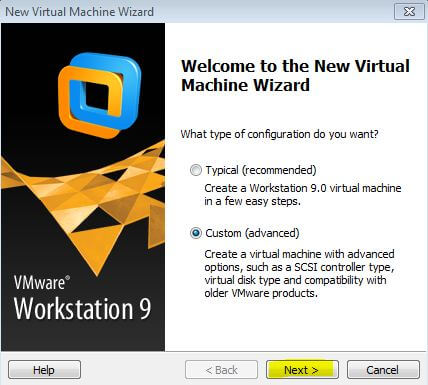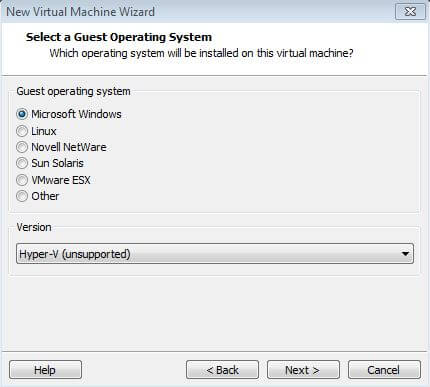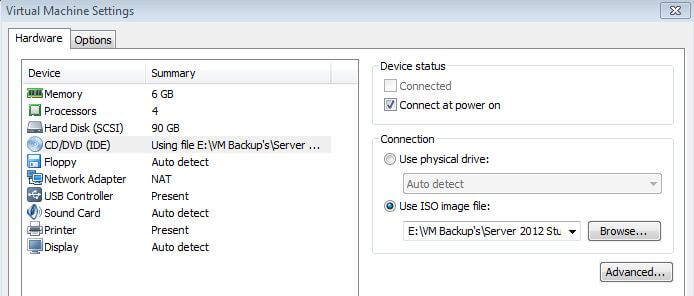- VMware Technology Network
- :
- Desktop Hypervisor
- :
- VMware Workstation
- :
- VMware Workstation Pro Discussions
- :
- Installing Windows Server 2012 in Workstation 9 or...
- Subscribe to RSS Feed
- Mark Topic as New
- Mark Topic as Read
- Float this Topic for Current User
- Bookmark
- Subscribe
- Mute
- Printer Friendly Page
- Mark as New
- Bookmark
- Subscribe
- Mute
- Subscribe to RSS Feed
- Permalink
- Report Inappropriate Content
Installing Windows Server 2012 in Workstation 9 or 10
I am trying to stand up a Windows 2012 server inside either Workstation 9 or 10 for testing.
I have the same error that the pc needs to be re-started when the iso try's to fire up. I have tried different iso files with the same results as below:
Your PC needs to restart.
Please hold down the power button.
error code: 0x000000C4
Parameters:
0x0000000000000091
0x000000000000000F
The error causes my physical machines to bleep and the following message appears as well:
A fault has occurred causing a virtual CPU to enter the shutdown state. If this fault had occurred outside of a virtual machine, it would have caused the physical machine to restart. The shutdown state can be reached by incorrectly configuring the virtual machine, a bug in the guest operating system, or a problem in VMware Workstation.
Click OK to restart the virtual machine or Cancel to power off the virtual machine
I have tried restarting the virtual and phyiscal machines and no change with the error
I have checked my machines and the installs of VM Workstation should be fine as I have many other VM's built and running just not any 2012 of Win 8 machines yet.
I am running workstation 9 on a Windows 7 Professional with SP1 laptop with 16gb RAM and Workstation 10 on a Windows 7 Professional with SP1 installed on an HP Z420 workstation with 32gb RAM
The VM team here had the same problem inside the ESX 5.1 farm and just upgraded to 5.5 and the problem went away so wondering what the fix is for Workstation
- Mark as New
- Bookmark
- Subscribe
- Mute
- Subscribe to RSS Feed
- Permalink
- Report Inappropriate Content
Install Windows Server 2012 as Virtual Machine in VMware Workstation
Posted by Bipin on February 6, 2013
Hyper V is one of the hottest feature of Windows Server 2012. You will definitely want to install Hyper V server role and play around with it. Installing Hyper V role in server 2008 in VMware Workstation was difficult until VMware released VMware Workstation 9. Here I will show you how to install Windows Server 2012 as virtual machine in VMware workstation 9 with Hyper V ready. So let’s get going.
Install Windows Server 2012 as Virtual Machine in VMware Workstation
Before installing Windows Server 2012 as virtual machine in VMware workstation you might want to make sure following things,
- At least 2 GB memory or more for Hyper V and nested VM installation.
- Processor that have Intel VT technology supported and enabled.
- At least 50 GB hard drive space or more for Hyper V virtual machine installation.
I am installing Server 2012 on my laptop running core i7 2670 processor with 16 GB RAM and 750 GB HDD with Windows 7 Ultimate. Here are the steps. Open VMware Workstation application from desktop. I am running VMware Workstation 9.
Click File from the Menu and select New Virtual Machine
Here choose Custom option and click Next button.
Choose Workstation 9 as hardware compatibility and click Next button. Under guest OS installation option, choose install operating system later. Click Next button.
Here I will choose Microsoft Windows as guest operating system and Hyper V as version. Click Next. Now name the virtual machine and browse the location to store this virtual machine and click Next button.
Under processor configuration, I will select 4 cores per processor and click Next.
I will select 6 GB of memory since I will be installing Hyper V and virtual machines under it. After configuring memory click Next.
In network type option choose NAT so that you can use Internet within the virtual machine. Then click Next button. Under I/O controllers type leave the default, LSI Logic SAS. Click Next button.
In select disk option, choose create new virtual disk and click Next button. In disk type, choose SCSI and click Next button.
Now, specify the disk capacity. I will enter 90 GB so that I will have enough space to install virtual machines in Hyper V. Then click Next button. Browse the location where you want to save the disk file. Click Next button.
Now you can see all the information in one place. If you think something is not right then you can click back and edit it. Click Finish button. Now click edit virtual machine settings to configure installation file of Server 2012.
As you can see below picture, select CD/DVD under device and browse the location of ISO installation file of Server 2012.
After configuration click OK button and click power on this virtual machine. You can now start installing Windows Server 2012.
After installation completes you can start using Windows Server
- Mark as New
- Bookmark
- Subscribe
- Mute
- Subscribe to RSS Feed
- Permalink
- Report Inappropriate Content
Does your physical CPU meet the requirements for Windows 2012? Specifically, does it support CMPXCHG16B?
- Mark as New
- Bookmark
- Subscribe
- Mute
- Subscribe to RSS Feed
- Permalink
- Report Inappropriate Content
You can check this with the Windows 8 Upgrade Assistant from Microsoft. Download the tool from http://windows.microsoft.com/en-US/windows-8/upgrade-to-windows-8 and run it on your physical host.
- Mark as New
- Bookmark
- Subscribe
- Mute
- Subscribe to RSS Feed
- Permalink
- Report Inappropriate Content
Hi
Welcome to the communities.
From error message it says most probably having problem with CPU ,
You need to CHECK BIOS settings and enable respective features of CPU.
- Mark as New
- Bookmark
- Subscribe
- Mute
- Subscribe to RSS Feed
- Permalink
- Report Inappropriate Content
Hi
Sorry for not replying sooner but yes checked using coreinfo and processor is CMPXCHG16B compliant but still can't install Windows 8 or Server 2012 with the same error.
What else am I missing here as surely it can't be this difficult to stand up the vm's on hardware that is only a year old.
I have copied the coreinfo output below...
Coreinfo v3.2 - Dump information on system CPU and memory topology
Copyright (C) 2008-2012 Mark Russinovich
Sysinternals - www.sysinternals.com
Intel(R) Xeon(R) CPU E5-1603 0 @ 2.80GHz
Intel64 Family 6 Model 45 Stepping 7, GenuineIntel
HTT * Hyperthreading enabled
HYPERVISOR - Hypervisor is present
VMX * Supports Intel hardware-assisted virtualization
SVM - Supports AMD hardware-assisted virtualization
EM64T * Supports 64-bit mode
SMX * Supports Intel trusted execution
SKINIT - Supports AMD SKINIT
NX - Supports no-execute page protection
SMEP - Supports Supervisor Mode Execution Prevention
SMAP - Supports Supervisor Mode Access Prevention
PAGE1GB * Supports 1 GB large pages
PAE * Supports > 32-bit physical addresses
PAT * Supports Page Attribute Table
PSE * Supports 4 MB pages
PSE36 * Supports > 32-bit address 4 MB pages
PGE * Supports global bit in page tables
SS * Supports bus snooping for cache operations
VME * Supports Virtual-8086 mode
RDWRFSGSBASE - Supports direct GS/FS base access
FPU * Implements i387 floating point instructions
MMX * Supports MMX instruction set
MMXEXT - Implements AMD MMX extensions
3DNOW - Supports 3DNow! instructions
3DNOWEXT - Supports 3DNow! extension instructions
SSE * Supports Streaming SIMD Extensions
SSE2 * Supports Streaming SIMD Extensions 2
SSE3 * Supports Streaming SIMD Extensions 3
SSSE3 * Supports Supplemental SIMD Extensions 3
SSE4.1 * Supports Streaming SIMD Extensions 4.1
SSE4.2 * Supports Streaming SIMD Extensions 4.2
AES * Supports AES extensions
AVX * Supports AVX intruction extensions
FMA - Supports FMA extensions using YMM state
MSR * Implements RDMSR/WRMSR instructions
MTRR * Supports Memory Type Range Registers
XSAVE * Supports XSAVE/XRSTOR instructions
OSXSAVE * Supports XSETBV/XGETBV instructions
RDRAND - Supports RDRAND instruction
RDSEED - Supports RDSEED instruction
CMOV * Supports CMOVcc instruction
CLFSH * Supports CLFLUSH instruction
CX8 * Supports compare and exchange 8-byte instructions
CX16 * Supports CMPXCHG16B instruction
BMI1 - Supports bit manipulation extensions 1
BMI2 - Supports bit maniuplation extensions 2
ADX - Supports ADCX/ADOX instructions
DCA * Supports prefetch from memory-mapped device
F16C - Supports half-precision instruction
FXSR * Supports FXSAVE/FXSTOR instructions
FFXSR - Supports optimized FXSAVE/FSRSTOR instruction
MONITOR * Supports MONITOR and MWAIT instructions
MOVBE - Supports MOVBE instruction
ERMSB - Supports Enhanced REP MOVSB/STOSB
PCLULDQ * Supports PCLMULDQ instruction
POPCNT * Supports POPCNT instruction
SEP * Supports fast system call instructions
LAHF-SAHF * Supports LAHF/SAHF instructions in 64-bit mode
HLE - Supports Hardware Lock Elision instructions
RTM - Supports Restricted Transactional Memory instructions
DE * Supports I/O breakpoints including CR4.DE
DTES64 * Can write history of 64-bit branch addresses
DS * Implements memory-resident debug buffer
DS-CPL * Supports Debug Store feature with CPL
PCID * Supports PCIDs and settable CR4.PCIDE
INVPCID - Supports INVPCID instruction
PDCM * Supports Performance Capabilities MSR
RDTSCP * Supports RDTSCP instruction
TSC * Supports RDTSC instruction
TSC-DEADLINE * Local APIC supports one-shot deadline timer
TSC-INVARIANT * TSC runs at constant rate
xTPR * Supports disabling task priority messages
EIST * Supports Enhanced Intel Speedstep
ACPI * Implements MSR for power management
TM * Implements thermal monitor circuitry
TM2 * Implements Thermal Monitor 2 control
APIC * Implements software-accessible local APIC
x2APIC * Supports x2APIC
CNXT-ID - L1 data cache mode adaptive or BIOS
MCE * Supports Machine Check, INT18 and CR4.MCE
MCA * Implements Machine Check Architecture
PBE * Supports use of FERR#/PBE# pin
PSN - Implements 96-bit processor serial number
PREFETCHW * Supports PREFETCHW instruction
Logical to Physical Processor Map:
*--- Physical Processor 0
-*-- Physical Processor 1
--*- Physical Processor 2
---* Physical Processor 3
Logical Processor to Socket Map:
**** Socket 0
Logical Processor to NUMA Node Map:
**** NUMA Node 0
Logical Processor to Cache Map:
*--- Data Cache 0, Level 1, 32 KB, Assoc 8, LineSize 64
*--- Instruction Cache 0, Level 1, 32 KB, Assoc 8, LineSize 64
*--- Unified Cache 0, Level 2, 256 KB, Assoc 8, LineSize 64
-*-- Data Cache 1, Level 1, 32 KB, Assoc 8, LineSize 64
-*-- Instruction Cache 1, Level 1, 32 KB, Assoc 8, LineSize 64
-*-- Unified Cache 1, Level 2, 256 KB, Assoc 8, LineSize 64
--*- Data Cache 2, Level 1, 32 KB, Assoc 8, LineSize 64
--*- Instruction Cache 2, Level 1, 32 KB, Assoc 8, LineSize 64
--*- Unified Cache 2, Level 2, 256 KB, Assoc 8, LineSize 64
---* Data Cache 3, Level 1, 32 KB, Assoc 8, LineSize 64
---* Instruction Cache 3, Level 1, 32 KB, Assoc 8, LineSize 64
---* Unified Cache 3, Level 2, 256 KB, Assoc 8, LineSize 64
**** Unified Cache 4, Level 3, 10 MB, Assoc 20, LineSize 64
Logical Processor to Group Map:
**** Group 0
- Mark as New
- Bookmark
- Subscribe
- Mute
- Subscribe to RSS Feed
- Permalink
- Report Inappropriate Content
Please post the vmware.log file as an attachment (use the advanced editor).
- Mark as New
- Bookmark
- Subscribe
- Mute
- Subscribe to RSS Feed
- Permalink
- Report Inappropriate Content
- Mark as New
- Bookmark
- Subscribe
- Mute
- Subscribe to RSS Feed
- Permalink
- Report Inappropriate Content
I see nothing unusual, except perhaps for what appear to be the remnants of a failed easy install. Have you checked the SHA-1 sum of the ISO image against the one published on the MSDN site?
If easy install is failing, you might want to try a fresh manual install.
- Mark as New
- Bookmark
- Subscribe
- Mute
- Subscribe to RSS Feed
- Permalink
- Report Inappropriate Content
We have a known issue in WS 10.0.1 where putting a virtual CD/DVD drive all alone on a SATA or SCSI controller can in some cases cause beeps. Does it still beep if you change the SATA virtual CD/DVD drive to IDE, and then remove the SATA controller? (To remove the SATA controller, you'll probably have to edit the .vmx file and change sata0.present = "TRUE" to sata0.present = "FALSE".)
I think the beeping issue is unrelated to the OS installation failure, but I'd be more than happy to be proven wrong on that score. ![]()
--
Darius
- Mark as New
- Bookmark
- Subscribe
- Mute
- Subscribe to RSS Feed
- Permalink
- Report Inappropriate Content
It looks like DEP (Data Execution Prevention) is disabled in your host's BIOS. Windows 2012 requires DEP. If it is disabled, you should enable it.











